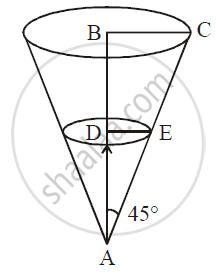Advertisements
Advertisements
Question
Water is dripping out from a conical funnel of semi-verticle angle `pi/4` at the uniform rate of `2 cm^2/sec`in the surface, through a tiny hole at the vertex of the bottom. When the slant height of the water level is 4 cm, find the rate of decrease of the slant height of the water.
Solution
Let r be the radius, h be the height and V be the volume of the funnel at any time t
`V = 1/3 pir^2h` ... (i)
Let I be the slant height of the funnel
Given: Semi-vertical angle = 45° in the triangle ADE:
`sin 45^@ = (DE)/(AE) => 1/sqrt2 = r/l`
`cos 45^@ = (AD)/(AE) => 1/sqrt2 = h/l`
`r = 1/sqrt2` and h = `1/sqrt2` ...(ii)
therefore the equation (i) can be rewritten as :
`V = 1/3 pi xx (I/sqrt2)^2 xx I/sqrt2 = pi/(3xx2xxsqrt2) xx I^3``
`V = pi/(6sqrt2) I^3` ...(iii)
Differentiate w.r.t. t :
`(dV)/(dt) = pi/(6sqrt2) xx 3l^2 xx (dl)/(dt)`
`(dv)/(dt) = pi/(2sqrt2) xx l^2 xx (dl)/(dt)`
`(dl)/(dt) = (2sqrt2)/(pil^2) xx (dV)/(dt)` ...(iv)
Since it is given that rate of change (decrease) of volume of water w.r.t. t is
`(dV)/(dt) = -2cm^3"/"sec`
therefore
`(dl)/(dt) = (2sqrt2)/(lambdal^2) xx (-2) = -(4sqrt2)/(lambdal^2)`
`(dl)/(dt)|_"at l = 4" = - (4sqrt2)/(pixx(4)^2) = - (sqrt2)/(4pi) "cm/sec"`

APPEARS IN
RELATED QUESTIONS
Test whether the function is increasing or decreasing.
f(x) = `"x" -1/"x"`, x ∈ R, x ≠ 0,
Prove that the function f given by f(x) = x2 − x + 1 is neither strictly increasing nor strictly decreasing on (−1, 1).
Prove that the function f given by f(x) = log cos x is strictly decreasing on `(0, pi/2)` and strictly increasing on `((3pi)/2, 2pi).`
Show that the function f(x) = 4x3 - 18x2 + 27x - 7 is always increasing on R.
Find the interval in which the following function are increasing or decreasing f(x) = 2x3 − 12x2 + 18x + 15 ?
Find the interval in which the following function are increasing or decreasing f(x) = x3 − 12x2 + 36x + 17 ?
Find the interval in which the following function are increasing or decreasing f(x) = \[5 x^\frac{3}{2} - 3 x^\frac{5}{2}\] x > 0 ?
Find the interval in which the following function are increasing or decreasing \[f\left( x \right) = 3 x^4 - 4 x^3 - 12 x^2 + 5\] ?
Determine the values of x for which the function f(x) = x2 − 6x + 9 is increasing or decreasing. Also, find the coordinates of the point on the curve y = x2 − 6x + 9 where the normal is parallel to the line y = x + 5 ?
Show that f(x) = x − sin x is increasing for all x ∈ R ?
Show that the function f(x) = sin (2x + π/4) is decreasing on (3π/8, 5π/8) ?
Find the set of values of 'a' for which f(x) = x + cos x + ax + b is increasing on R ?
State whether f(x) = tan x − x is increasing or decreasing its domain ?
If the function f(x) = 2x2 − kx + 5 is increasing on [1, 2], then k lies in the interval
Let \[f\left( x \right) = \tan^{- 1} \left( g\left( x \right) \right),\],where g (x) is monotonically increasing for 0 < x < \[\frac{\pi}{2} .\] Then, f(x) is
Let f(x) = x3 − 6x2 + 15x + 3. Then,
If the function f(x) = kx3 − 9x2 + 9x + 3 is monotonically increasing in every interval, then
If x = cos2 θ and y = cot θ then find `dy/dx at θ=pi/4`
Choose the correct option from the given alternatives :
Let f(x) = x3 – 6x2 + 9x + 18, then f(x) is strictly decreasing in ______.
Solve the following:
Find the intervals on which the function f(x) = `x/logx` is increasing and decreasing.
Show that function f(x) =`3/"x" + 10`, x ≠ 0 is decreasing.
f(x) = `{{:(0"," x = 0 ), (x - 3"," x > 0):}` The function f(x) is ______
If f(x) = `x^(3/2) (3x - 10)`, x ≥ 0, then f(x) is increasing in ______.
Prove that the function f(x) = tanx – 4x is strictly decreasing on `((-pi)/3, pi/3)`
Find the interval in which the function `f` is given by `f(x) = 2x^2 - 3x` is strictly decreasing.
Function f(x) = x100 + sinx – 1 is increasing for all x ∈ ______.
Let f(x) = `x/sqrt(a^2 + x^2) - (d - x)/sqrt(b^2 + (d - x)^2), x ∈ R` where a, b and d are non-zero real constants. Then ______.
The interval in which the function f(x) = `(4x^2 + 1)/x` is decreasing is ______.
If f(x) = `x/(x^2 + 1)` is increasing function then the value of x lies in ______.
Read the following passage:
|
The use of electric vehicles will curb air pollution in the long run. V(t) = `1/5 t^3 - 5/2 t^2 + 25t - 2` where t represents the time and t = 1, 2, 3, ...... corresponds to years 2001, 2002, 2003, ...... respectively. |
Based on the above information, answer the following questions:
- Can the above function be used to estimate number of vehicles in the year 2000? Justify. (2)
- Prove that the function V(t) is an increasing function. (2)

